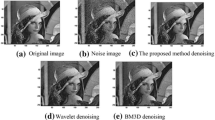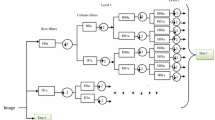Abstract
Image denoising is a procedure aimed at removing noise from images while retaining as many important signal features as possible. Many images suffer from poor contrast due to inadequate illumination or finite sensitivity of the imaging device, electronic sensor noise or atmospheric disturbances. This paper proposes a hybrid directional lifting technique for image denoising to retain the original information present in the images. The primary objective of this paper is to show the impact of applying preprocessing techniques for improving classification accuracy. In order to classify the image accurately, effective preservation of edges and contour details of an image is essential. The discrete wavelet transform-based interpolation technique is developed for resolution enhancement. The image is then classified using support vector machine classifier, which is well suitable for image classification. The efficiency of the classifier is analyzed based on receiver operating characteristic (ROC) curves. The quantitative performance measures peak signal to noise ratio and ROC analysis show the significance of the proposed techniques.








Similar content being viewed by others
References
Chatterjee, P., Milanfar, P.: Is denoising dead? IEEE Trans. Image Process. 19(4), 895–911 (2010)
Mallat, S.G., Hwang, W.L.: Singularity detection and processing with wavelets. IEEE Trans. Inf. Theory 38, 617–643 (1992)
Donoho, D.L.: De-noising by soft-thresholding. IEEE Trans. Inf. Theory 41(3), 613–627 (1995)
Sweldens, W.: The lifting scheme: a custom-design construction of biorthogonal wavelets. Appl. Comput. Harmon. Anal. 3(2), 186–200 (1996)
Imola, K., Kamath, C.: Denoising through wavelet shrinkage: an empirical study. J Electron. Imaging 12(1), 1–16 (2001)
Fan, G., **a, X.-G.: Image denoising using local contextual hidden Markov model in the wavelet domain. IEEE Signal Process. Lett. 8(5), 125–128 (2001)
Piella, G., Pesquet-Popescu, B., Heijmans, H.J.A.M.: Adaptive update lifting with a decision rule based on derivative filters. Signal Process. Lett. 9, 329–332 (2002)
Achim, A., Panagiotis, T., Bezerianos, A.: SAR image denoising via Bayesian wavelet shrinkage based on heavy-tailed modeling. IEEE Trans. Geosci. Remote Sens. 41(8), 1773–1784 (2003)
Xu, H., Xu, J., Wu, F.: Lifting-based directional dct-like transform for image coding. IEEE Trans. Circuits Syst. Video Technol. 17(10), 1325–1335 (2007)
Wenpeng, D., Feng, W.: Adaptive directional lifting based wavelet transform for image coding. IEEE Trans. Image Process. 16(2), 416–684 (2007)
Chang, C.L., Girod, B.: Direction-adaptive discrete wavelet transform for image compression. IEEE Trans. Image Process. 16(5), 1289–1302 (2007)
Zhang, X., Wu, X., Wu, F.: Image coding on quincunx lattice with adaptive lifting and interpolation. In: Data Compression Conference, pp. 193–202 (2007)
Sharmila, T.S., Ramar, K.: Efficient analysis of hybrid directional lifting technique for satellite image denoising. Signal, Image Video Process. (2012). doi:10.1007/s11760-012-0369-2
Yi-bo, L., Hong, X., Sen-yue, Z. The wrinkle generation method for facial reconstruction based on extraction of partition wrinkle line features and fractal interpolation. In: Proceedings of the 4th ICIG, pp. 933–937, (2007)
Rener, Y., Wei, J., Ken, C.: Downsample-based multiple description coding and post-processing of decoding. In: Proceedings of CCC, pp. 253–256, (2008)
Celik, T., Kusetogullari, H.: Self-sampled image resolution enhancement using dual-tree complex wavelet transform. In: European Signal Processing Conference. Glasgow, Scotland (2009)
Hildebrand, A., Falldorf, C., Christoph von, K., Bergmann, R.B.: Resolution enhancement by time-multiplexed acquisition of sub-pixel shifted images employing a spatial light modulator. In: International Symposium on Optomechatronic Technologies, Germany, pp. 1–6 (2010)
Demirel, H., Anbarjafari, G.: Discrete wavelet transform-based satellite image resolution enhancement. IEEE Trans. Geosci. Remote Sens. Lett. 49(6),1997–2004 (2011)
Demirel, H., Anbarjafari, G.: Image resolution enhancement by using discrete and stationary wavelet decomposition. IEEE Trans. Image Process. 20(5),1458–1460 (2011a)
Demirel, H., Anbarjafari, G.: Satellite image resolution enhancement using complex wavelet transform. IEEE Trans. Geosci. Remote Sens. Lett. 7(1), 123–126 (2010)
Aplin, P., Atkinson, P.M., Curran, P.J.: Per-field classification of land use using the forthcoming very fine spatial resolution satellite sensors: problems and potential solutions. In: Atkinson, P.M., Tate, N.J. (eds.) Advances in Remote Sensing and GIS Analysis, pp. 219–239. Wiley, New York (1999)
Lefsky, M.A., Cohen, W.B.: Selection of remotely sensed data. In methods and applications for remote sensing: concepts and case studies. Wulder and Franklin. Dordnecht, Kluwer Academic Publishers, 13–46 (2003)
Corbane, C., Baghdadi, N., Descombes, X., Wilson Jr, G., Villeneuve, N., Petit, M.: Comparative study on the performance of multiparameter SAR data for operational urban areas extraction using textural features. IEEE Geosci. Remote Sens. Lett. 6(4), 728–732 (2009)
Luis, S., Schulz, K.: Supervised classification of agricultural land cover using a modified K-NN technique (KNN) and landsat remote sensing imagery. Remote Sens. 1, 875–895 (2009)
Rowman, J.F., George, P.T.: Geological units classification of multispectral images by using support vector machines. In: International Conference on Intelligent Networking and Collaborative Systems, pp. 267–272 (2009)
Nath, K., Deb, S.K.: Water-body area extraction from high resolution satellite images—an introduction, review, and comparison. Int. J. Image Process. 3(6), 353–372 (2010)
Corbane, C., Baghdadi, N., Xavier, D., Wilson Jr, G., Villeneuve, N., Petit, M.: Comparative study on the performance of multiparameter SAR data for operational urban areas extraction using textural features. IEEE Geosci. Remote Sens. Lett. 6(4), 728–732 (2009)
Wang, Z.-Z., Yong, J.-H.: Texture analysis and classification with linear regression model based on wavelet transform. IEEE Trans. Image Process. 17(8), 1421–1430 (2008)
Chethan, H.K., Raghavendra, R.: Texture based approach for cloud classification using SVM. In: International Conference on Advances in Technologies in Communication and Computing, pp. 688–690, 2009. doi:10.1109/ARTCom.2009.43.
Sree Sharmila, T., Ramar, K., Vidhusha, S.: Change detection water-body in synthetic aperture radar images. Int. J. Image Process. 6(4), 223–242 (2012)
Huang, B., **e, C., Tay, R., Wu, B.: Land-use-change modeling using unbalanced support-vector machines. Environ. Plan. B Plann. Des. 36, 398–416 (2009)
Perumal, K., Bhaskaran, R.: SVM-based effective land use classification system for multispectral remote sensing images. Int. J. Comput. Sci. Inf. Secur. 6(2), 95–107 (2009)
Byun, H. Lee, S.-W.: Application of support vector machines for pattern recognition: a survey. In: SVM 2002, LNCS 2388, pp. 213–236 (2002)
Sun, B.X., Huang, D.S.: Texture classification based on support vector machine and wavelet transform. In: Proceedings of the Fifth World Congress on, Intelligent Control and Automation, pp. 15–19 (2004)
Powell, R.L., Matzke, N., De Souza, C., Clark, M., Numata, I., Hess, L.L., Roberts, D.A.: Sources of error in accuracy assessment of thematic land-cover maps in the Brazilian Amazon. Remote Sens. Environ. 90, 221–234 (2004)
Congalton, R.G., Plourde, L.: Quality assurance and accuracy assessment of information derived from remotely sensed data. In: Bossler, J. (ed.) Manual of Geospatial Science and Technology, pp. 349–361. Taylor & Francis, London (2002)
Author information
Authors and Affiliations
Corresponding author
Rights and permissions
About this article
Cite this article
Sree Sharmila, T., Ramar, K. & Sree Renga Raja, T. Impact of applying pre-processing techniques for improving classification accuracy. SIViP 8, 149–157 (2014). https://doi.org/10.1007/s11760-013-0505-7
Received:
Revised:
Accepted:
Published:
Issue Date:
DOI: https://doi.org/10.1007/s11760-013-0505-7




